Story and photos by Michelle Sutton

Which path shall we take next?
In September, I headed to Syracuse to do story interviews.
Person after person said, “Dianne Bordoni! You must see her garden.”
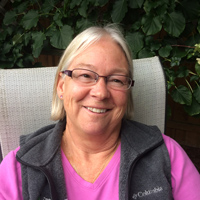
Dianne Bordoni
Dianne and Dan Bordoni live in Fayetteville, a suburb of Syracuse, on a flat, modest-sized lot they purchased in 1985. The gardens she has created and the plant collections she has assembled, with a focus on dwarf conifers, are world-class. When I visited in September, Dianne had recently come off of hosting 200 American Conifer Society (ACS) members who were in town for their summer conference. Conifer enthusiasts found so much to explore in her collection, and the labeling was so thorough, that they went away sated and happy, as did I.
Imagine you are touring the Bordoni gardens with us. First, meet Dianne, our guide. She grew up in Ithaca and spent summers with her family at their camp in the Adirondacks. Her father was a professor at Cornell’s School of Agriculture and Life Sciences who specialized in fisheries and the ill effects of acid rain. Dianne’s dad encouraged her love of plants, both domesticated and wild. They gardened together and he paid her a penny for every dandelion she dug out by the roots, something she actually loved doing. For her sixteenth birthday, Dianne’s father bought her an “Empire State” climbing rose, and they planted it together.
“I loved to walk through the woods and I loved to grow things,” she says. “I’d collect mosses and little pine seedlings to make terrariums. Even when I went back to college (Skidmore, geology major) each fall, I took all my plants, supplies, and grow lights with me.” Dianne thinks that her early interest in terrariums and tiny plants foreshadowed her eventual passion for dwarf conifers. What’s also true is that she can collect a maximum variety of plants on her property if she focuses mostly on dwarfs and miniatures.
We are joined by our mutual friend Pat Tobin, also from Fayetteville, who chairs the tree commission there and has been steadfastly involved with the New York State Urban Forestry Council for more than 20 years. She and Dianne know one another from the local garden club. Pat has brought a leaf from a volunteer vine in her garden for us to ID. We take a picture of the leaf, do a reverse Google image search, and determine it is Dutchman’s pipe (Aristolochia macrophylla). It must be courtesy of bird droppings.
Dianne points out the one lovely, very large limbed-up yew and the one juniper they didn’t pull out when they cleared the property back in the 1980s. At the time, the property was a mess, feral cats darting in and out of the enormous overgrown shrubs. The clearing was heavy work… many chainsaw blades broke.

Starting our tour, with three very cute dogs watching silently from the sliding glass doors.

Acer palmatum ‘Beni Hime’ grows to about two feet tall in central New York
• • •
“It’s important to know that dwarf conifers and other plants can vary greatly in their growth rate and ultimate size,” Dianne says. “Some max out at six feet, some at sixteen feet. ‘Dwarf’ is a relative thing. For instance, there are dwarf giant sequoia cultivars that range greatly in ultimate dimensions.” Miniature = stays small. Dwarf = grows slowly, but doesn’t necessarily stay small. Dwarf conifers are expensive because it takes so long to bring them to saleable size and because their availability in the trade can be limited.
“Just buy them very small,” Bordoni says. “Invest in watching their slow growth.” She points to a dwarf Japanese maple with orangered summer foliage called ‘Beni Hime’. It’s about fourteen inches tall, and it’s darling. As we three coo over it, Dianne explains how it’s actually helpful to have lots of snow so that small plants like this are insulated both from (some) critters and from temperature fluctuations.
Speaking of those fluctuations, you’re not alone in your horticultural heartbreak. Dianne lost a dozen mature Japanese maples in the spring of 2016 after a fluke set of conditions. “Everything was warming freakishly early in March…the sap on the maples was rising early as it does,” she says. “Then we had a sudden change in temperature—this atrocious storm with bitter cold…the sap in the trunks froze in place, and the cells burst, killing the trees.” Smaller maples that were insulated by snow were ok, but the mature ones were zapped. There was nothing to prevent it. “I still love Japanese maples, however,” she says. “They’re so varied and interesting, and they are relatively pest-free.”
In the winter, the dwarf conifers are the stars of the garden, along with winterberry hollies (Ilex verticillata), like the orange-fruited ‘Afterglow’ we are now admiring. “If you only have a green palette, you start noticing the many shades of green,” she says. “Also, many conifers fire up a more intense or different color in the winter.” No matter how much snow is on the ground, she will find her way out to the garden almost every day in the winter, to prune, take stock, and admire.
Dwarf conifers are relatively pest-free if given the Right Plant, Right Place treatment. Dianne shows me how she cleans out all the dead needles in the plant interior to keep the branch junctions free of debris that could collect moisture and favor fungal diseases. You can shake or comb out your little specimens, or even use a high-power hose, she explains.
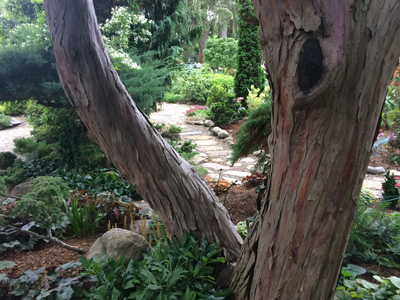
View through the (60-plus year-old) yew
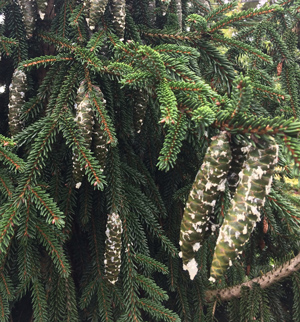
Foliage and cones of Picea orientalis
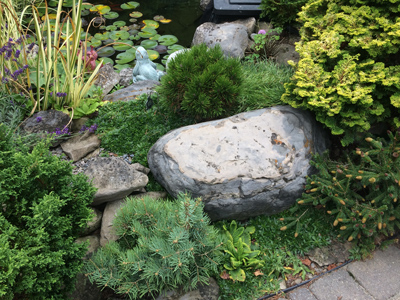
The infamous rock extracted during clandestine pond dig
• • •
I ask the inevitable question about favorites. Dianne says, “A lot of the newer varieties haven’t been around long enough to see them mature and know the potential pitfalls, like whether they keep their shape or open up and become rangy, like Hinoki cypress does.” She points to a gorgeous oriental spruce (Picea orientalis) with its characteristic tight bundles of tiny needles. “Oriental spruces keep their shape as they grow and they always look good—they never brown out,” she says. I mention that they’re one of the top conifers for urban use because they are so tough and adaptable. “They’re so reliable, I’ll snatch up any new variety,” she says.
Oriental spruces are the group of conifers she likes best, but her favorite single specimen on the property is a handsome, stout alpine fir (Abies lasiocarpa ‘Compacta’) that maxed out at around ten feet tall. As we’re checking that out, I become aware of three doggies watching us from the sliding glass doors. They’ve been silent this whole time, until I turn to look at them. Dianne tells me that the doggie in the middle, a golden retriever, likes to retrieve plant tags out of the garden, which makes labeling an ongoing challenge. She is smiling as she tells me this. The dogs are fully accommodated—for instance, she set up the path system based on the run paths of the tail waggers.
Because they are more work, Dianne is gradually scaling back on perennials. The ones she’s keeping are more unusual, like orange and peach-blooming, fully winter hardy, perennial Peruvian lilies (Alstroemeria sp.) in the “Inca” series. “I’ve had them for years and you talk about a workhorse—these bloom like there’s no tomorrow,” she says. And she has some striking dahlias that provide color and interest in September and October and into early November.
• • •
Everywhere you look is a harmonious vista. And within those vistas are plants with deep familial meaning: the golden-foliage Japanese maple she planted after her mother’s passing; trees planted to mark the birth of her grandkids; and plant tokens of friendship. Dianne and Dan (a lawyer who prefers the great indoors) have three kids—Daniel, Christopher, and Caitlin—and four grandchildren. Timothy, seven, and Annalin, nine, live nearby and are super into playing in the dirt at Grandma’s. Granddaughters Cari, five, and Paige, three, live in Virginia and are more into dolls and faeries.
The backyard pond has its own familial significance. “I always wanted a pond, but my husband said it was too much work. So while he was gone one weekend, I enlisted my youngest son, Christopher (then eight years old), to help me dig it,” Dianne says. “We dug and dug until we hit this big rock about four feet down on the bottom and when we got the rock up, we knew we were finished.”
Peonies also have family associations. When oldest son Daniel was attending Hamilton College in Clinton (where the unusual Root Glen arboretum can be found), Dianne would visit him for his swim team meets. Hamilton Chemistry Professor A.P. Saunders was an accomplished peony hybridizer; Dianne got into collecting some of his introductions. When in bloom, they bring to mind Daniel and her visits. She recommends folks go to Hamilton College in late May or early June to see the collection of Saunders peonies on display. See Root Glen as well!
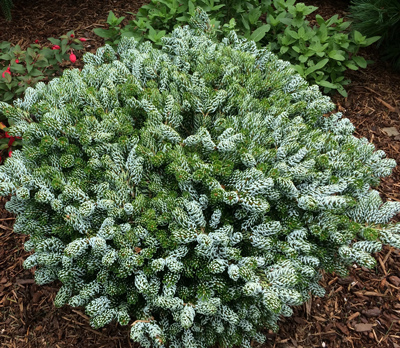
Acer koreana ‘Ice Breaker’ was the American Conifer Society’s 2014 Conifer of the Year.

Anemone hupehensis ‘Splendens’
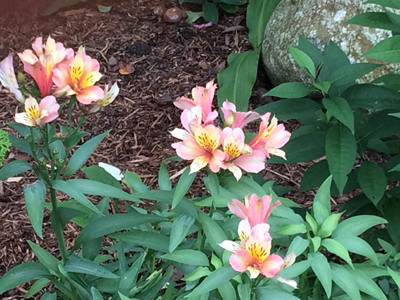
Perennial alstroemeria from the Inca Series

This Pinus strobus ‘Mini Twist’ grows in a perfect ball shape, no shearing required.
• • •
I’ve heard that hosting garden tours can be very stressful, so I ask Dianne about this. After all, she had 200 people come through in two shifts in one morning. She says, “I don’t do home-and-garden–type tours, where things are supposed to be perfect and where you’re expected to yield to certain fussy conventions, like around color combinations.” Instead, she opens the gardens to fellow plant collectors who like to talk plants and plant culture, who are understanding about the inevitable ravages of nature on the garden, and who like to admire specimens together.
Michelle Sutton (michellejudysutton.com) is a horticulturist, editor, and writer.
Views: 19




